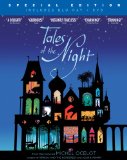| Reviews & Columns |
|
Reviews DVD TV on DVD Blu-ray 4K UHD International DVDs In Theaters Reviews by Studio Video Games Features Collector Series DVDs Easter Egg Database Interviews DVD Talk Radio Feature Articles Columns Anime Talk DVD Savant Horror DVDs The M.O.D. Squad Art House HD Talk Silent DVD
|
DVD Talk Forum |
|
|
| Resources |
|
DVD Price Search Customer Service #'s RCE Info Links |
|
Columns
|
|
|
Tales of the Night
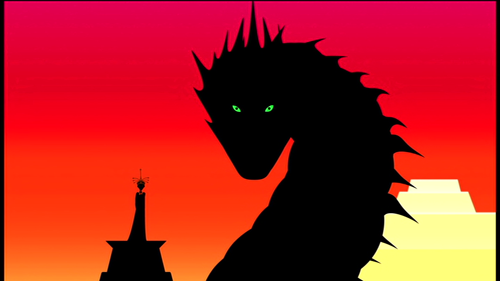
The Movie
Note: the screen captures accompanying this review are taken from the DVD edition of Tales of the Night.
A visually dazzling animated film from French writer-director Michel Ocelot, Tales of the Night explores the enduring appeal of classic verbal storytelling - the kind your mom employed to tuck you into bed (do moms even do that anymore?). The six short tales that comprise Tales are enacted in vibrant CGI, set in exotic lands, and told entirely in silhouette. If the varied segments tend to be hit-and-miss in content, the film's bold, inventive look gives it a consistency that places it alongside other recent acclaimed animated flicks such as A Cat in Paris and Chico & Rita.
As Tales unfolds, a good sense of what Ocelot drew from in creating this film emerge: folklore, fairy tales, shadow puppet theatre, even a bit of opera. The vaguely defined framing structure Ocelot uses to hang these tales upon takes place in an abandoned theater in a nighttime city, where an older man (a director?) discusses various folk tale plots and settings with two energetic young people (animators?). After setting up each story with the help of a costume-creating robot (with a hoot owl perched atop, strangely), the boy and girl characters troop onstage and the screen is given over to the following mini-episodes:
In Night of the Werewolf, a young knight besotted with a royal beauty becomes engaged to her spiteful sister. Before their wedding is to occur, the man tells his bride-to-be that he's been cursed to change into a werewolf every full moon. Only his gold necklace he's wearing stops the hairiness from happening, a spell that threatens to keep the guy in a state of perpetual wolfness when the resentful princess attempts to destroy the object.
The lovely, Caribbean-set J.J. and Beauty Unknowing concerns a happy-go-lucky guy who tumbles down a cave into an underground kingdom, a place that is his to claim if he can solve a series of difficult puzzles set forth by a king with three identical princess daughters. This delightful segment probably gets at the feel of classic folklore most successfully of the six stories, with an engaging plot full of gem-like twists (it also involves mutant-sized animals - need I say more?).
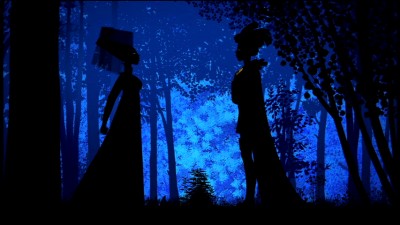
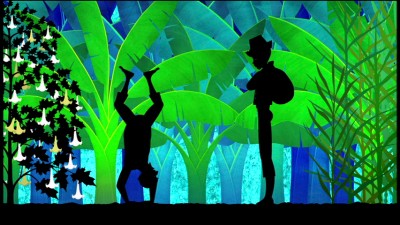
The Chosen One of the Golden City is set in an Aztec-era Mexican society who regularly performs a ritualized human sacrifice ceremony to placate a huge, fearsome dragon. The people in the community take it for granted that its most beautiful women must be given over to the monster, a tradition that is broken by the inquisitiveness of a brave outsider knight (who is also in love with the current would-be victim). This segment awkwardly uses opera arias to tell its slight, only somewhat compelling story.
With Tom Tom Boy, we turn to Africa and the tale of a young villager who loves nothing more than beating out a steady rhythm on whatever nearby surface suits his needs. His talent leads him to the mentorship of an old man whose life he saved, and a magic tom-tom drum that (with the boy's help) saves his village from illness and invading marauders. Bolstered by stylized imagery set against golden-hued skies and a terrific story, this segment is another of the film's winners.

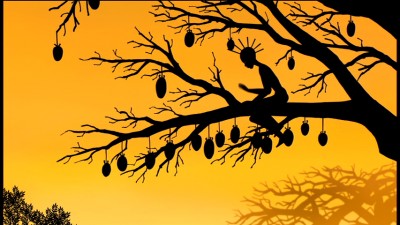
The Tibet-set The Boy Who Never Lied takes on a more sinister turn, following a boy with a horse whose incredible gift for human speech steals the thunder of the singing horse owned by the royal court. A manipulative princess, posing as a sickly traveling beggar, attempts to persuade the horse's smitten owner into making an unspeakable sacrifice to save her life. Although it's somewhat draggy at times, this was another unique segment that benefits greatly from stunning visuals (using a giant ancient Tibetian mandala as a background, for instance).
For the final segment, The Young Doe and the Architect's Son, Medieval France becomes the setting for a story in which an eager young peasant boy embarks on an adventure to save the kidnapped princess he's in love with. Before Thiebaud can finally locate Maud, however, her captor strikes her with a magic spell that sends the boy and his guide on a journey that leads to a magic fairy encased in a giant egg.
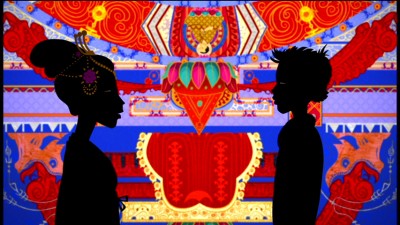
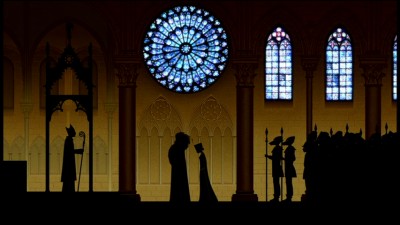
I'd qualify Tales of the Night as a half-success - it certainly is unique, and the old-form-meets-modern-technology aesthetic is pulled off with vividness and panache (the impressiveness would have been more pronounced had it been made with paper cutouts instead of CGI, however). Ocelot's dialogue-driven screenplay relies heavily on scenes with two people simply talking, however - a tact which becomes wearying as the film rolls along. It might be more forgivable if the dialogue was clever, but it seems as if Ocelot was a bit hamstrung by adhering closely to a classic folk tale template (it does succeed, however, in capturing that plainspoken yet surreal tone present in the Grimm brothers and other fairy tales from the 19th century and before). Opinions may vary, but the silhouette style with its limited expressiveness, while interesting, doesn't hold up to 84 minutes of feature film. Fans of European animation will likely enjoy it, despite being long on style and painfully short on substance. In that respect, it calls to mind a stylish oddity like the 2006 black and white dystopian fantasy Renaissance, rather than the kind of films that get Oscar award nominations and well-earned spots in one's home theater collection.
The Blu Ray:
New Video's "Special Edition" of Tales of the Night includes the film on Blu Ray and DVD, wrapped in standard blu case with a metallic foil cardboard sleeve. On the particulars of the presentation below, I'll be referring to the blu ray.
Video
Blu Ray is an ideal vehicle for the crisp, colorful, digitally animated imagery at the heart of Tales of the Night, and in that respect the disc does not disappoint (even the DVD edition looks good). If the colors seemed too intensely keyed at times, the mastering is beautifully done with sharp-edged shapes (no halos) and sumptuous, detailed textures.
Audio
Tales of the Night's original French soundtrack is a standard stereo affair, pleasantly mixed with clear dialogue and an unobtrusive score. The film doesn't have a lot of occasion for showiness on the sound mix, but the track serves its purpose well. For the disc edition, New Line also supplied the film with a dub spoken in British-accented English, available in 5.0 and 2.0 stereo on the DVD. Optional English subtitles are also provided.
Extras
Aside from the U.S. Trailer, which does the usual job of marketing the visuals over the dialogue (none of which is heard), the Blu Ray and DVD contain the same two featurettes: An Interview with Michel Ocelot (18:25) is a straightforward Q&A (illustrated with a few film clips) in which the director yields questions on a spare, modern apartment set. Although the questions sometimes veer towards the pretentious, it's a decent talk that sheds some light on Ocelot's methods and inspirations. Featurette The Festival of Color: Storytelling through Animation (12:35) accompanies Ocelot as he presents a screening of one of the Tales segments at a UNICEF benefit in Bordeaux, France.
Final Thoughts:
With Tales of the Night, French animation director Michel Ocelot weaves six folklore-inspired stories into a unique film told entirely in silhouette. Children will likely be fatigued by the dialogue-heavy repetitiveness of it all, but teens and adults with an interest in offbeat animation may find it a lush, colorful diversion. Mildly recommended.
Matt Hinrichs is a designer, artist, film critic and jack-of-all-trades in Phoenix, Arizona. Since 2000, he has been blogging at Scrubbles.net. 4 Color Cowboy is his repository of Western-kitsch imagery, while other films he's experienced are logged at Letterboxd. He also welcomes friends on Twitter @4colorcowboy.
|
| Popular Reviews |
| Sponsored Links |
|
|
| Sponsored Links |
|
|
| Release List | Reviews | Shop | Newsletter | Forum | DVD Giveaways | Blu-Ray | Advertise |
|
Copyright 2024 DVDTalk.com All Rights Reserved. Legal Info, Privacy Policy, Terms of Use,
Manage Preferences,
Your Privacy Choices | |||||||









